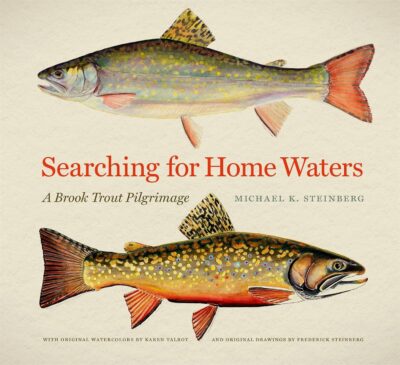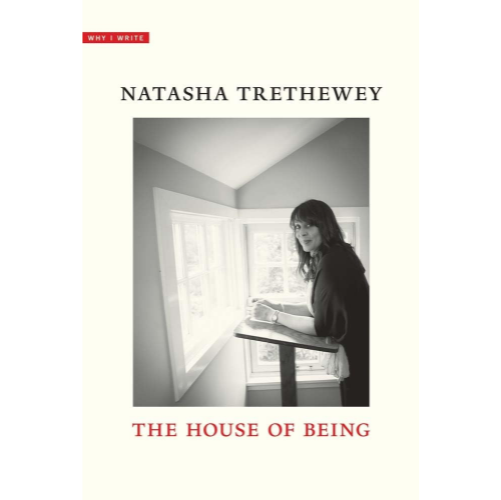Searching for Home Waters: A Brook Trout Pilgrimage
By Michael K. Steinberg
University of Georgia Press, 2023
Hardcover: $39.95
Genre: Travel Memoir, Ecology and Environment, Trout Fishing
Reviewed by Edward Journey
“Poetics of place” is a phrase used by Michael K. Steinberg in his captivating book, Searching for Home Waters: A Brook Trout Pilgrimage. The phrase references a morning spent on Vermont’s Robert Frost Interpretive Trail, but it applies to Steinberg’s very personal pursuit for habitats of the brook trout on the east coast of North America. His quest encompasses diverse waterways encountered over four years of fishing from the southern Appalachians of north Georgia to Canada’s Labrador region.
Steinberg first appeared on my radar with his intriguing 2008 book, Stalking the Ghost Bird (Louisiana State University Press), which tracked sightings of the ever-elusive (and possibly extinct) ivory-billed woodpecker. A professor of geography, Steinberg directs the environmental studies minor at the University of Alabama’s New College. He is an enthusiastic and knowledgeable fly fisherman who is partial to brook trout and their environs. He uses that knowledge and enthusiasm to craft a book that addresses environment and wildlife, conservation and destruction, science and spirit, and fishing – lots of fishing.
Making clear that Searching for Home Waters is not a “how-to” book, Steinberg describes the sport of fly-fishing as “solitary, even selfish.” The book takes a conversational, personal tone and on occasion becomes a tale of avoiding traffic and people. “A Zen rhythm or focus is impossible amid a crowd,” he writes. Fly-fishing has become, for Steinberg, “my form of meditation.” He asserts that his “home waters” – the places where he feels a most personal connection – “reflect critical parts of my personality, my family life, and my professional life.” Indeed, much of Steinberg’s personal story is revealed in the pages of this lovely, informative, and cautionary book. The text is further enhanced by a gallery of original watercolors by Maine-based artist Karen Talbot, which attest to the beauty and variety of brook trout. Assorted drawings of insects and lures by Frederick Steinberg appear throughout.
“Brook trout landscapes remain my topophilic home waters,” writes Steinberg. Brook trout (or “brookies”) are clearly a passion for the author, although they might be less known than the non-native rainbow and brown trout that have displaced many of their habitats in eastern North America. Steinberg, a relative late-comer to trout fishing, “knew intuitively that brook trout were somehow nobler than bass and catfish.” He describes the brook trout as a painting of “all the colors of a fall Appalachian forest on this one small, living palette.” Certain glacial lakes and ponds in Maine, which contain some of the author’s home waters, have been home to brook trout since the last ice age and “contain certain genetic strains found nowhere else on the planet.” Steinberg follows a determined “catch and release” regimen, and his catches are often only six to eight inches long – a decent size, actually, for brookies in many of the waters he fishes. In Vermont, the call of a hermit thrush reminds him “why I hike up those streams, battling bugs and bruised shins to catch six-inch fish.” He does it for the challenge and the beauty and love of the place and the prey. Indeed, there is a spiritual component to his observations.
Steinberg writes that “[book trout] presence tells us a great deal about the health of the larger environment.” He provides a state-by-state examination of brook trout ecology and, by extension, the environmental health of the region. He interviews environmental activists and administrators, anglers and guides, and representatives of Trout Unlimited as he travels. There are hopeful success stories of streams brought back to life as well as the occasional loss. The strong connection between forests and stream habitat is explored, as are the benefits of forestry “chop and drop” policies for stream health. He examines the ongoing impacts of acid rain, deforestation, mining, large-scale and intensive farming, suburbanization, fracking, and warm water hazards from construction pollutants. In Massachusetts, we learn of the environmental damage from cranberry bogs! Waiting in a large SUV at an entrance to Shenandoah National Park, he acknowledges his complicity in the effects of “industrial tourism.” Century-old decisions affect our environment today and beyond. Even so, Searching for Home Waters is not a book of dire warnings, but of hope and progress, albeit guarded at times.
Vivid descriptions of waterways, landscapes, and a sense of place are found throughout the text. At a restaurant in Asheville, “the sweet smell of patchouli traveled from the dance floor like a thick blanket of mountain fog.” In West Virginia, Steinberg is awed by the unlikely and triumphant sight of dozens of wind turbines on high hilltops. He and a guide angle in a stream a few feet behind a suburban Pennsylvania home with the hum of a lawnmower in the distance. In the Adirondacks, he catches a twenty-inch brown trout in a pool “no bigger than a hot tub.” In Labrador, the first brook trout he catches is “the biggest and most beautiful brookie of my life.” His glee is palpable. On Labrador nights after fishing, loons call from dark lakes as the northern lights take the place of the sun.
Admittedly, my own fishing experience is limited to youthful cane pole-fishing from a bank or a pier or an occasional boat. I used a rod and reel once or twice and helped bait a trotline at my grandparents’ river house. Even so, Searching for Home Waters is a compelling, informative, and eye-opening adventure up the eastern edges of the continent. It is an often meditative book that teaches the reader to, in Steinberg’s words, “slow down and to be mindful, to be present in a specific place and a specific activity.”
Edward Journey, a retired university professor and theatre professional living in Birmingham, regularly shares his essays in the online journal “Professional Southerner” (www.professionalsoutherner.com). View Edward Journey’s profile in the Alabama Authors Directory.






